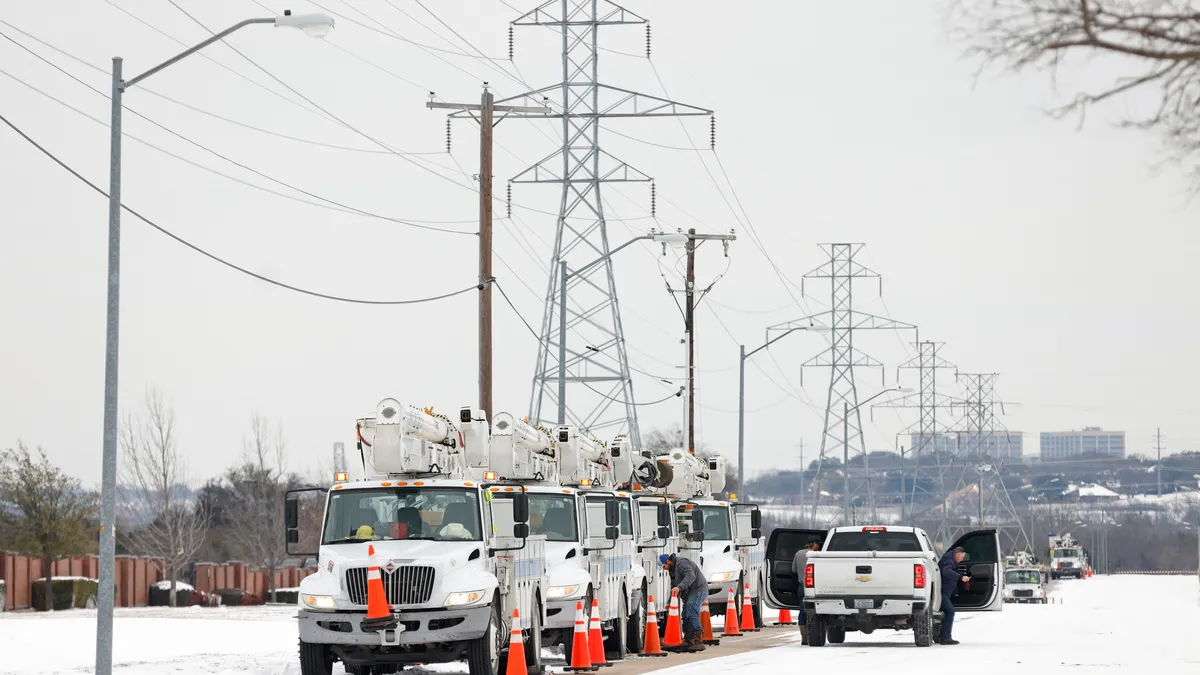Dive Brief:
- California, Texas, New England and parts of the Midwest face an "elevated risk" of energy emergencies this summer, exacerbated by the growth of intermittent resources and the likelihood of extreme weather, the North American Electric Reliability Corp. (NERC) said on Wednesday.
- NERC President and CEO Jim Robb told reporters the 2021 Summer Reliability Assessment "underscores my increased concerns about the changes we're seeing on the grid and the potential consequences for reliability."
- California is at risk of energy emergencies even during periods of normal peak summer demand, NERC concluded, and is at "high risk when above-normal demand is widespread in the West." The summer assessment indicates 10,185 MWh of energy in the state is expected to go unserved this summer.
Dive Insight:
NERC hinted a week ago, in a preview of its summer assessment, that four regions could face potential energy shortages this summer. The full report identifies the extent of the possible deficiencies, and Robb told reporters of his own concerns about how the energy transition might be impacting reliability.
"In our hurry to develop a cleaner resource base, reliability and energy adequacy have to be taken into consideration," he said.
Robb has previously discussed challenges to the reliability paradigm created by a bulk power system that is rapidly becoming more decarbonized, distributed and digitized. "This 3-D transformation is bringing significant benefits to the industry," he said, including improved economics and a reduced environmental footprint, "but at the cost of rapidly increasing operating complexity."
NERC officials say the summer assessment is a warning about both the near- and longer-term risks of the grid's changing resource mix. But, Robb said, this is not a criticism of decarbonization.
"I want to be clear, this is not a call against the transition," he said, "but rather a plea for attention to the pace of change and the challenges created for system operators."
4 regions could face shortages
The highest risk this summer is in California, where NERC sees Western Interconnection resource levels similar to 2020 levels. Texas also faces risks, though reserve margins have improved in the state. Both states recently faced reliability issues during periods of extreme weather and demand.
The Electric Reliability Council of Texas lost almost half its generation during a February cold snap that left millions without power. In California, a summer 2020 heat wave forced the grid operator to utilize blackouts to avoid a grid collapse.
Over 3 GW of additional resources are expected online in California for this summer, but NERC said most of that will be coming in the form of new solar. "These generation plants can provide energy to support peak demand; however, solar PV output falls off rapidly in late afternoon while high demand often remains," the report says.
Transferring capacity into the balancing area may be necessary to offset reduced solar generation in late afternoon, said NERC.
California ISO officials pointed to their own 2021 Summer Loads and Resources Assessment, in response to the NERC report. The grid operator "anticipates supply conditions in 2021 to be better than 2020, but continues to see potential challenges in meeting demand during extreme heat waves," the report said.
In Texas, NERC said on-peak planning reserve margins have increased to 15.3% from 12.9% last summer, with the addition of almost 8 GW of wind, solar and battery resources since 2020.
"However, extreme weather can affect both generation and demand and cause energy shortages that lead to energy emergencies," the report said. "Furthermore, with a significant portion of electricity supply coming from wind generation, operators must have sufficient flexible resources to cover periods of low-wind output."
ERCOT officials say they expect there will be sufficient generation to meet peak loads this summer, but have also outlined three low-probability scenarios where extreme weather could lead to blackouts.
The Midcontinent ISO and New England have sufficient resources for periods of peak demand, NERC said, but added that above-normal levels of demand associated with a 1-in-10 chance weather forecast event "are likely to exceed capacity resources and require additional non-firm transfers from surrounding areas."
Recommendations
The latest reliability assessment is "quite concerning," John Moura, NERC's director of reliability assessment and performance analysis, told reporters.
Summer 2020 and winter 2021 were "difficult to say the least," Moura said, and the latest assessment signals "similar risks" lie ahead.
Load serving entities should be working with reliability coordinators to ensure clear lines of communications, reviewing outage schedules and assessing the potential for energy imports, said Moura. For an area like California, that means engineering studies, generator commitments and transmission analysis, to ensure power will be available and can be moved long distances.
System operators should also start conducting drills, particularly in areas with elevated risk, to practice calls for energy and voltage conservation. Demand-side management and demand response programs should be brought into play, and load serving entities should consider signing up more commercial and industrial customers, said Moura.
Load serving entities should also review their inventory of non-firm customers and rolling blackout procedures, to ensure critical facilities are not impacted by any load disconnections or early calls for conservation, said Moura.
In the long-term, system operators must do extensive analysis to ensure the addition of variable resources will not negatively impact reliability, he added. "As we look forward, it really just looks more stressful," Moura said, "because of the different resources coming onto the system."
CORRECTION: A previous version of this story misstated how NERC President and CEO Jim Robb characterized the industry benefits of the energy transition. He said they include a reduced environmental footprint.















